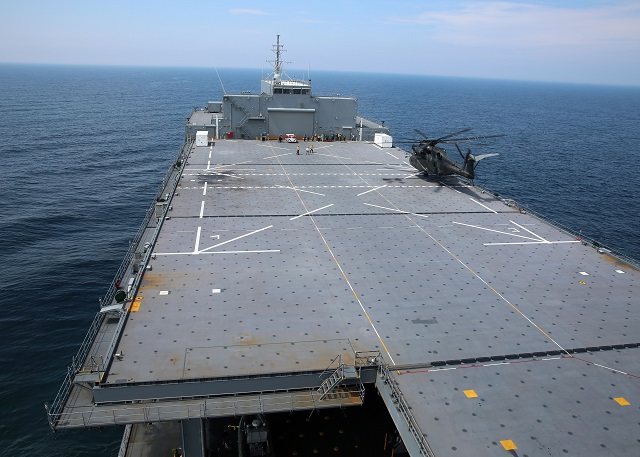|
|
|||
 ATLANTIC OCEAN (June 16, 2016) A U.S. Navy MH-53 Sea Dragon helicopter attached to Helicopter Mine Countermeasures Squadron 15 (HM-15) lands on the flight deck of Military Sealift Command's expeditionary mobile base, USNS Lewis B. Puller (T-ESB 3). Sailors from HM-15 worked in concert with Sailors and Civil Service Mariners serving aboard Puller on a four-day Airborne Mine Countermeasure Deployment training exercise. (U.S. Navy Photo by Bill Mesta/Released) ATLANTIC OCEAN (June 16, 2016) A U.S. Navy MH-53 Sea Dragon helicopter attached to Helicopter Mine Countermeasures Squadron 15 (HM-15) lands on the flight deck of Military Sealift Command's expeditionary mobile base, USNS Lewis B. Puller (T-ESB 3). Sailors from HM-15 worked in concert with Sailors and Civil Service Mariners serving aboard Puller on a four-day Airborne Mine Countermeasure Deployment training exercise. (U.S. Navy Photo by Bill Mesta/Released) |
|||
|
|
|||
|
The 784 foot-long vessel features a 52,000 square-foot flight deck, fuel and equipment storage, repair spaces, magazines, and mission-planning spaces. Able to accommodate up to 250 personnel, USNS Lewis B. Puller will support multiple missions, such as air mine counter measures, counter-piracy operations, maritime security operations, humanitarian aid and disaster relief missions, and crisis response operations.
According to McCarthy, the Puller is going to be permanently deployed overseas, which saves a tremendous amount of time in terms of operations. So the ship's maintenance, repairs and crew swaps will take place in theater. USNS Lewis B. Puller is named after Lt. Gen, Lewis Burwell "Chesty" Puller, one of the most decorated members of the Marine Corps. He is one of only two men, and the only Marine, to be awarded five Navy Crosses. He fought in Haiti and Nicaragua, and participated in battles of World War II and the Korean War. Puller retired from the Marine Corps in 1955 and spent the remainder of his life in Virginia. USNS Lewis B. Puller is the expeditionary sea base-variant of the expeditionary transfer dock (ESD) which includes USNS Montford Point (T-ESD 1) and USNS John Glenn (T-ESD 2). The second expeditionary sea base, USNS Hershel "Woody" Williams (T-ESB 4), is currently under construction by General Dynamics National Steel and Shipbuilding Company (NASSCO) in San Diego. MSC operates approximately 120 non-combatant, civilian-crewed ships that replenish U.S. Navy ships, conduct specialized missions, and strategically preposition combat cargo at sea around the world, while moving military cargo and supplies used by deployed U.S. forces and coalition partners. |
|||
Expeditionary Sea Base USNS Lewis B. Puller Begins First Operational Deployment
- Posted On











